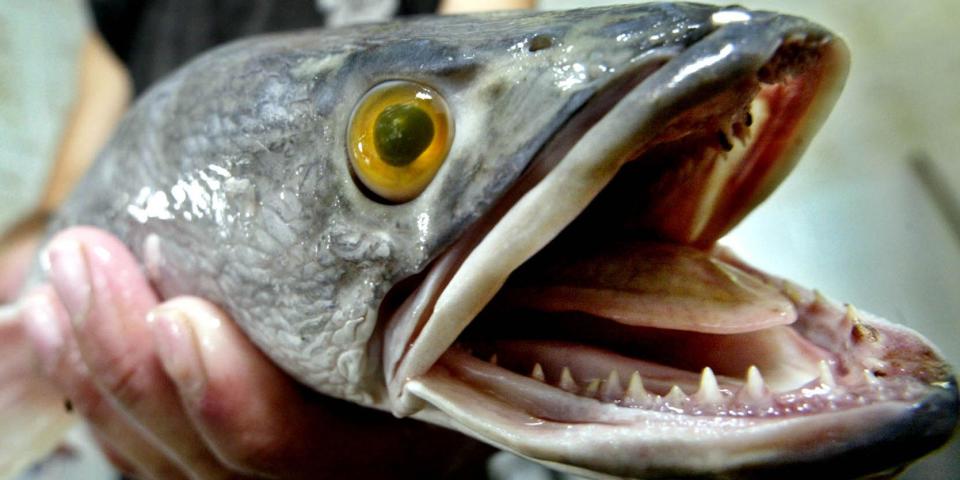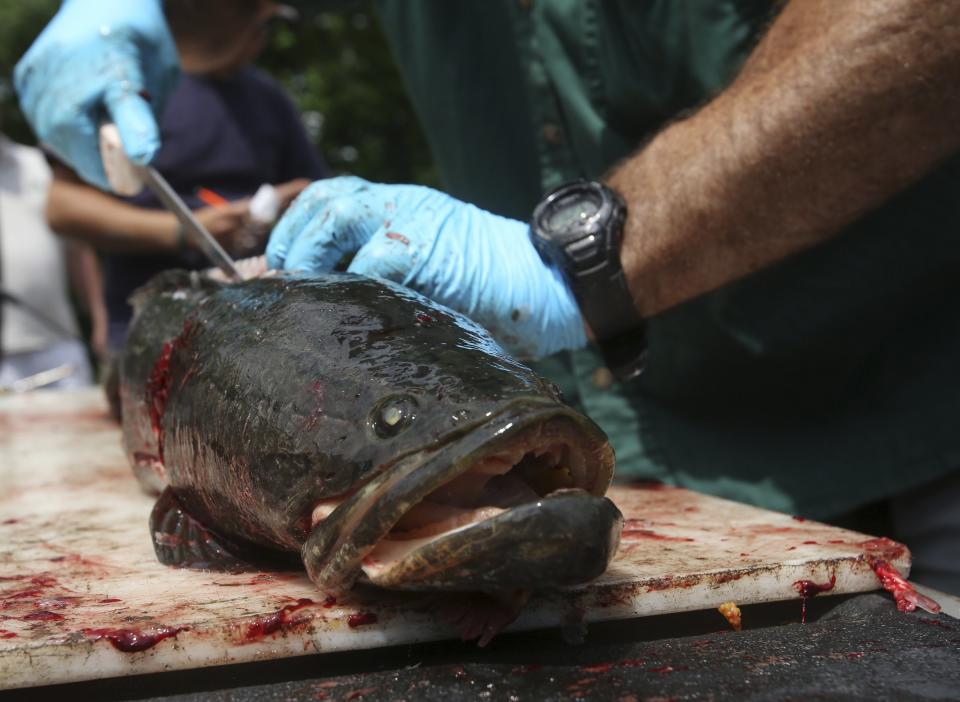In case you didn't have enough to worry about, there are now fish that can walk on land
A northern snakehead fish, a predator with razor sharp teeth that can travel on land, was caught by an angler in Georgia on Wednesday. The fish is an invasive species that can out-compete native wildlife, and officials are advising residents that come across a snakehead fish to "kill it immediately."
The northern snakehead fish has reportedly been found in 15 US states, according to the Georgia Wildlife Resources Division, though they are native to waters in Asia and Africa.
Snakehead fish can grow up to three feet long and breathe air, allowing the fish to survive on land and travel by tossing its body side-to-side — an equivalent to walking — according to National Geographic.
The fish were at one point cultured in Arkansas until a federal ban was established in 2002, making it illegal to import, transport, sell, transfer, or possess any species of snakehead fish, of which there are 29 known varieties.
A predatory fish with razor sharp teeth that can survive and travel on land was caught by an angler in Georgia earlier this month.
The fish was identified as a snakehead fish, an invasive species that can out-compete native wildlife, and officials are advising residents that come across the creature to "kill it immediately."
The fish was caught by an angler in a pond on privately owned property in Gwinnett County, Georgia. Thrown off by the odd-looking nature of the fish, the angler took a picture and threw it back into the water, according to The New York Times. After reporting it to a state biologist, a team went back out on the water and found a two-foot snakehead fish and three juveniles.

The northern snakehead fish has reportedly been found in 15 US states, according to the Georgia Wildlife Resources Division, though they are native to waters in Asia and Africa.
In two years, a female snakehead fish can release up to 150,000 eggs, but without a competing predator outside its natural habitat to keep its population in check, the land-dwelling fish can pose a threat to local animals.
"They are a predator that eats mostly other fish, but also amphibians, small animals, frogs, lizards," Scott Robinson from the Wildlife Resources Division told The Times. "It will compete with our native species for food and habitat."
Snakehead fish survive in freshwater, The Times reported. They can grow up to three feet long and breathe air, allowing them to survive on land. The fish travel by tossing their bodies side-to-side — an equivalent to walking — according to National Geographic.
Read more: The Asian Snakehead Fish That Was Found In Maryland Is Aggressive And Spreading

REUTERS/Gary Cameron
What to do if you find a snakehead fish
Georgia officials advise residents to not release snakehead fish if you come across them. Instead, "kill it immediately and freeze it." After the capture and kill, officials say to take photos of the fish, note the location where it was caught, and then report it to Georgia's Wildlife Resources Division Fisheries Office.
In terms of preventative measures, officials wrote the following:
Learn how to identify northern snakehead.
Dispose of aquarium animals and plants in the garbage, not in waterbodies.
Dispose of all bait in trash cans, at disposal stations, or above the waterline on dry land.
Dump water from boat compartments, bait buckets, and live wells on dry land.

Reuters/Gary Cameron
The snakehead fish is considered a delicacy, but also a danger
Snakehead fish are typically harvested in farms in China for consumption. They have shown up on plates in Chinatown in Boston and New York. The fish were also once kept as aquarium pets until they proved to be too "aggressive," Dr. Lynne Parenti, curator of fishes at the National Museum of Natural History, told The Times.
The fish were at one point cultured in Arkansas until a federal ban was established in 2002, making it illegal to import, transport, sell, transfer, or possess any species of snakehead fish, of which there are 29 known varieties, according to National Geographic. The species was added to an "injurious wildlife" list, according to the US Fish and Wildlife Service.
"These fish are like something from a bad horror movie," former Secretary of the Interior Gale Norton said in a 2002 statement. "... They have the potential to cause enormous damage to our valuable recreational and commercial fisheries. We simply must do everything we can to prevent them from entering our waters, either accidentally or intentionally."

